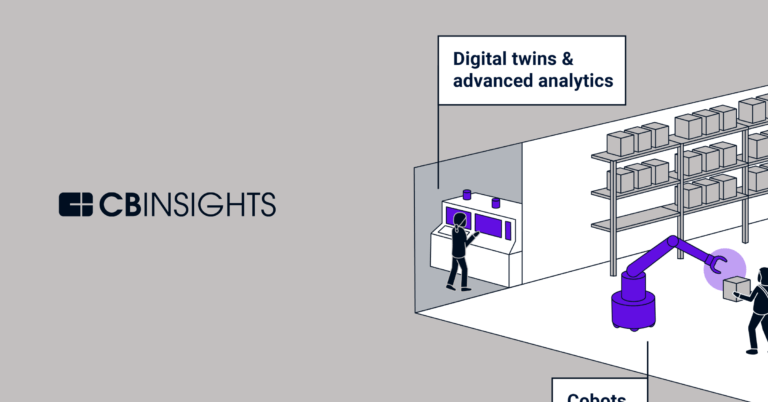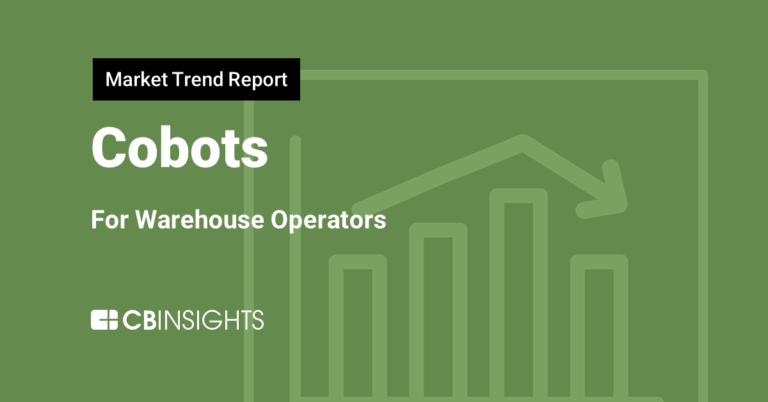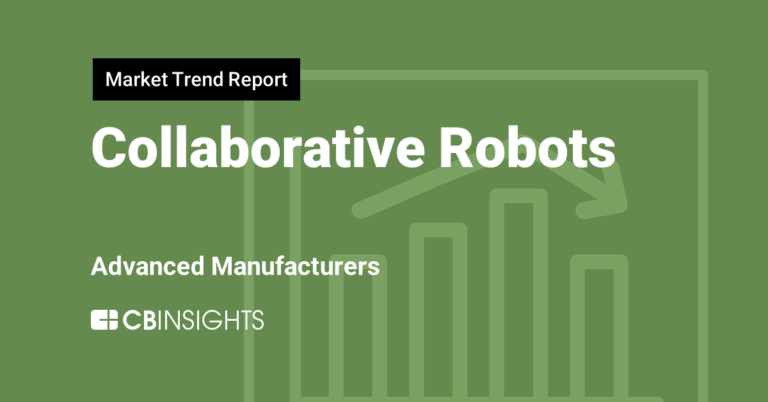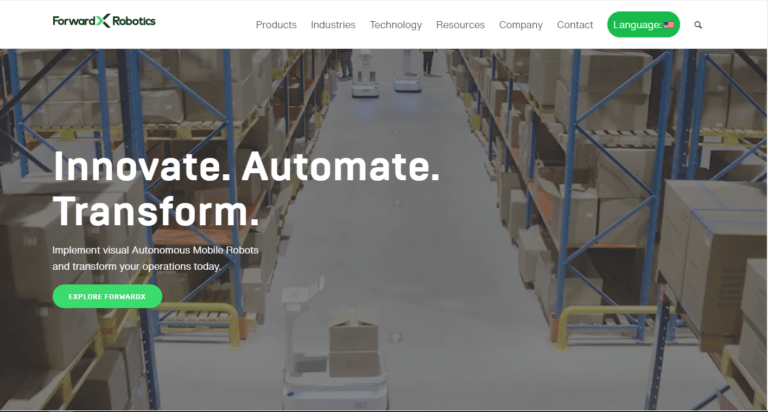
Locus Robotics
Founded Year
2014Stage
Series F - II | AliveTotal Raised
$432.82MMosaic Score The Mosaic Score is an algorithm that measures the overall financial health and market potential of private companies.
-48 points in the past 30 days
About Locus Robotics
Locus Robotics specializes in AI-driven warehouse automation solutions within the robotics industry. The company provides autonomous mobile robots that work collaboratively with humans to enhance productivity and operational efficiency in warehouses. Locus Robotics primarily serves sectors such as third-party logistics, retail and eCommerce, healthcare, and industrial sectors. It was founded in 2014 and is based in Wilmington, Massachusetts.
Loading...
ESPs containing Locus Robotics
The ESP matrix leverages data and analyst insight to identify and rank leading companies in a given technology landscape.
The automated guided vehicles (AGVs) & autonomous mobile robots (AMRs) market offers solutions for automating material handling processes in manufacturing, distribution, and logistics centers. These solutions include not only software for building, deploying, and operating robotic fleets but also algorithms for autonomous navigation and perception in dynamic environments. The market also offers si…
Locus Robotics named as Highflier among 15 other companies, including ABB, KUKA, and Symbotic.
Loading...
Research containing Locus Robotics
Get data-driven expert analysis from the CB Insights Intelligence Unit.
CB Insights Intelligence Analysts have mentioned Locus Robotics in 5 CB Insights research briefs, most recently on Sep 28, 2023.

Sep 28, 2023
The automation in advanced manufacturing market map
Expert Collections containing Locus Robotics
Expert Collections are analyst-curated lists that highlight the companies you need to know in the most important technology spaces.
Locus Robotics is included in 10 Expert Collections, including Supply Chain & Logistics Tech.
Supply Chain & Logistics Tech
5,371 items
Companies offering technology-driven solutions that serve the supply chain & logistics space (e.g. shipping, inventory mgmt, last mile, trucking).
Unicorns- Billion Dollar Startups
1,244 items
Robotics
2,006 items
This collection includes startups developing autonomous ground robots, unmanned aerial vehicles, robotic arms, and underwater drones, among other robotic systems. This collection also includes companies developing operating systems and vision modules for robots.
Smart Cities
1,307 items
Smart building tech covers energy management/HVAC tech, occupancy/security tech, connectivity/IoT tech, construction materials, robotics use in buildings, and the metaverse/virtual buildings.
Artificial Intelligence
14,769 items
Companies developing artificial intelligence solutions, including cross-industry applications, industry-specific products, and AI infrastructure solutions.
Conference Exhibitors
5,302 items
Locus Robotics Patents
Locus Robotics has filed 54 patents.
The 3 most popular patent topics include:
- distribution (business)
- manufacturing
- robotics

Application Date | Grant Date | Title | Related Topics | Status |
|---|---|---|---|---|
3/7/2023 | 9/10/2024 | Robot navigation, Robotics, Association football forwards, Web applications, Biomorphic robots | Grant |
Application Date | 3/7/2023 |
|---|---|
Grant Date | 9/10/2024 |
Title | |
Related Topics | Robot navigation, Robotics, Association football forwards, Web applications, Biomorphic robots |
Status | Grant |
Latest Locus Robotics News
Sep 19, 2024
News provided by Share this article Share toX NEW DELHI, Sept. 19, 2024 /PRNewswire/ -- According to LogisticsIQ's latest report (5th edition), Warehouse Automation Market is expected to grow to $55 Billion by 2030, at a CAGR of 15% between 2024 and 2030. The drivers of growth are the growth in the e-commerce industry, multichannel distribution channels, digital services, increasing e-grocery penetration and dark stores, globalization of supply chain networks, emergence of autonomous mobile robots (AMRs) and increasing demand for same day / same hour delivery. Market Trends and Key Drivers E-Commerce Boom and Its Impact on Logistics The exponential growth of the e-commerce industry has significantly transformed the $5 trillion global logistics industry. Online retail requires more complex logistical processes, including individual picking, packing, and shipping, which contrasts with the bulk transportation model of brick-and-mortar retail. This surge in online retail, coupled with the increasing need for faster delivery times, is putting immense pressure on logistics providers to automate. Challenges and Market Conditions (2021-2025) In 2021, warehouse automation companies had a huge order intake, however, revenue growth was constrained by supply chain disruptions. Thus, the industry entered in 2022 with a backlog of orders, which was eventually reduced by 2023 due to macroeconomic uncertainties. In 2024, order volumes began to rise again, but cautious capital expenditure from retailers slowed down investments due to inflation, low consumer spending, and geopolitical tensions. We expect order volumes expected to rebound in 2025 as retailers aim to meet increasing consumer demand. Emerging Technologies and Market Players The past few years have seen the emergence of cutting-edge technologies like automated picking systems, mobile manipulators, and automated cold storage solutions. Significant investments in companies like Symbotic, Geek+, Fabric, and Exotec Solutions reflect this growth. At the same time, established players such as Dematic, Honeywell Intelligrated , SSI Schafer, and Toyota Advanced Logistics continue to innovate. Additionally, major retailers including Walmart, Kroger, Amazon , Ocado, and Carrefour are actively adopting these technologies to enhance their supply chain capabilities. Apart this, piece picking players such as Righthand Robotics, Nimble, Fizyr, Kindred, Covariant, OSARO, Plus One Robotics, Berkshire Grey, and AWL have established a new attractive capability for order picking in ecommerce fulfillment as picking is least automated process in existing warehouses. Download a Free Sample of our report on the Warehouse Automation Market. Industry Consolidation in Warehouse Automation Market Over the last decade, the warehouse automation market has experienced significant consolidation. Traditional industry players are acquiring innovative technology leaders to stay competitive and address evolving market demands. Notable examples include: Rockwell Automation's acquisition of Clearpath Robotics and OTTO Motors Zebra's acquisition of Fetch Robotics Toyota's acquisition of Vanderlande, Bastian Solutions and ViaStore Honeywell's acquisition of Intelligrated and Transnorm Jungheinrich acquired Magazino and Arculus SSI Schafer acquired DS Automotion ABB acquired ASTI Mobile Robotics and Sevensense KPI Solutions acquired Kuecker Logistics Group, Pulse Integration, QC Software Körber acquired Cohesio Group, Siemens Logistics, HighJump Teradyne acquired MiR, Energid, AutoGuide Mobile Robots These mergers and acquisitions reflect the ongoing shift towards automation and the integration of cutting-edge technologies across the supply chain. Key Markets and Growth Opportunities Top Markets: The United States, China, and Germany account for more than 50% of the demand for warehouse automation, with strong market penetration in Europe, particularly in Germany, Italy, France, and the Netherlands. Western Europe represents around 30% of the global market. Emerging markets in APAC, particularly in India and Southeast Asia, are also showing strong growth potential, as are regions like the Middle East and Latin America. Emerging opportunities: Latin America is still under-penetrated with regards to automation; however, things are set to change and market is set to observe a high growth in Brazil and Mexico. Within Europe, Central and Eastern Europe is a fast-growing region, with Poland and Czech Republic emerging as logistics hub and showing good growth prospects. Grocery Industry: The grocery sector is a key area for warehouse automation, driven by the need for high-frequency deliveries and the growing demand for online grocery services. Grocery distributors ship high cubic volumes of merchandise to retail stores with frequent deliveries to ensure product freshness. Grocery distribution center operations are amongst the most labour intensive of any industry. Grocery automation market is expected to reach over $7 billion by 2030. AGV and AMR Market Growth: The market for Automated Guided Vehicles (AGVs) and Autonomous Mobile Robots (AMRs) is projected to experience rapid growth, with a CAGR of over 20% by 2030. AMRs, which can operate without external guidance systems like optical tape or sensors, are becoming increasingly popular due to their ease of deployment in existing warehouse infrastructures. We expect AGVs/AMRs to have more than 20% market share by 2030 in this market led by players such as Seegrid, Balyo, Hai Robotics, Geek+, GreyOrange, HikRobot, Quicktron, Locus Robotics, Fetch Robotics (Zebra), 6 River Systems (Ocado), Teradyne (MiR, AutoGuide Mobile Robots), Rocla, JBT, ek-robotics, Omron, Rockwell Automation (Clearpath Robotics, OTTO Motors). We further see more consolidation and M&A in the mobile robots space as larger System integrators look to complete their product portfolios. Order Picking and Automation Trends Manual vs. Automated Picking: The order picking process remains one of the most labor-intensive tasks in the warehouse, especially in e-commerce fulfillment. While manual picking is still preferred for operations with a large variety of SKUs, automated picking systems and robotic solutions are gaining traction. Technologies such as RFID, pick-to-light, and pick-to-voice systems help improve efficiency even in semi-automated environments. Piece Picking Robots: Companies such as Righthand Robotics, Berkshire Grey, Osaro, and Covariant are leading the charge in developing piece picking robots that are ideal for e-commerce fulfillment. These robots significantly reduce labor costs and increase throughput, offering a high return on investment for businesses. 500+ Pages, 290+ Exhibits and 350+ Market tables for 7 major Industry Verticals (eCommerce, Grocery, General Merchandise, Apparel, Food & Beverage, 3PL, Wholesale) 10 Technologies (Mobile Robots, AS/RS, Conveyors, Sortation, Order Picking, Automatic Identification and Data Capture (AIDC), Palletizing and Depalletizing Robots, Overhead systems, Software (Warehouse Management, Warehouse Execution, and Warehouse Control), and MRO services. 6 regions and 28 countries (United States, Canada, United Kingdom, Germany, France, Italy, Spain, Netherlands, Nordics, China, Japan, India, Australia, Thailand, Vietnam, Singapore, Indonesia, South Korea, Malaysia, Philippines, Taiwan, Saudi Arabia, UAE, Turkey, South Africa, Argentina, Brazil, Mexico) Pivot-friendly Excel file with 350+ market tables including forecast till 2030 In-depth analysis of 700 companies in the ecosystem with more than 140+ company profiles Focus Group Discussion with 100+ key industry stakeholders across the value chain to collect the first-hand information to validate our analysis 2 Analyst Sessions to brainstorm further Investment details with 150+ M&A and 750+ funding deals LogisticsIQ™ Exclusive Market Map (~700 Players across 15+ categories) About LogisticsIQ LogisticsIQ is a dedicated market research and advisory firm in Logistics & Supply Chain sector, empowering decision makers from top fortune 1000 companies, financial and research institutions, private equity and high potential start-ups with market insights to make better decisions. We enable this by analysing the right mix of the best data, the best research methodologies, and the best industry panel to deliver value to our clients. Media Contact
Locus Robotics Frequently Asked Questions (FAQ)
When was Locus Robotics founded?
Locus Robotics was founded in 2014.
Where is Locus Robotics's headquarters?
Locus Robotics's headquarters is located at 301 Ballardvale Street, Wilmington.
What is Locus Robotics's latest funding round?
Locus Robotics's latest funding round is Series F - II.
How much did Locus Robotics raise?
Locus Robotics raised a total of $432.82M.
Who are the investors of Locus Robotics?
Investors of Locus Robotics include G2 Venture Partners, Scale Venture Partners, Bond, Goldman Sachs Asset Management, Stack Capital and 15 more.
Who are Locus Robotics's competitors?
Competitors of Locus Robotics include Seegrid, Quicktron, TakeOff, Vecna Robotics, Humatics and 7 more.
Loading...
Compare Locus Robotics to Competitors

Scallog is a company that specializes in logistics robotics within the technology and logistics industries. The company offers advanced software and hardware technologies that optimize order preparation for e-commerce and industrial specialists, with a focus on automating warehouses. The main products include mobile robots that can lift and transport storage shelves to different picking stations, and software solutions that allow real-time tracking and organization of inventory. Scallog primarily serves the e-commerce, retail, and industrial sectors. It was founded in 2013 and is based in Nanterre, France.

Geek+ specializes in smart logistics, operating primarily in the robotics industry. The company offers a range of autonomous mobile robots that handle tasks such as picking, sorting, and industrial material handling, providing solutions for logistics and warehouse automation. It primarily serves sectors such as e-commerce, apparel, retail, logistics, pharmaceutical, and manufacturing. The company was founded in 2015 and is based in Beijing, China.

GreyOrange focuses on providing automated robotic fulfillment and inventory optimization solutions in the logistics and retail sectors. Their main services include offering automated solutions for warehouse operations and retail stores, which help increase productivity, mitigate labor challenges, and reduce risk. These solutions are powered by artificial intelligence and are designed for warehouse performance and drive shopper engagement in retail stores. It was founded in 2012 and is based in Roswell, Georgia.

Onward Robotics coordinates humans and robots as a cohesive system for intralogistics fulfillment. The company combines proprietary software with mobile robots to increase operational efficiency and eliminate downtime in warehousing, distribution, and fulfillment centers. The Pyxis technology integrates with company's WMS to prioritize orders, direct and assign tasks, and communicate directly with human workers for continuous and accurate workflow. The company serves industries that include eCommerce, Third Part Logistics, Industrial Warehousing, and Medical supply chains. Onward Robotics was formerly known as IAM Robotics. It was founded in 2012 and is based in Pittsburgh, Pennsylvania.

inVia Robotics specializes in warehouse automation solutions. The company offers artificial intelligence (AI) powered software and robotic systems designed to orchestrate tasks and improve productivity in warehouse operations. inVia Robotics solutions cater to e-commerce distribution centers and supply chains seeking to enhance efficiency and accuracy. It was founded in 2015 and is based in Westlake Village, California.
Opex Corporation is a company that focuses on automation technology in the warehouse and document/mail sectors. The company offers services such as warehouse automation, ecommerce fulfillment, document imaging, digital mail, and medical record digitization, all aimed at improving workflow and driving efficiencies in infrastructure. Opex Corporation primarily serves sectors that require automation solutions, such as the ecommerce industry and the document and mail processing industry. It was founded in 1973 and is based in Moorestown, New Jersey.
Loading...


